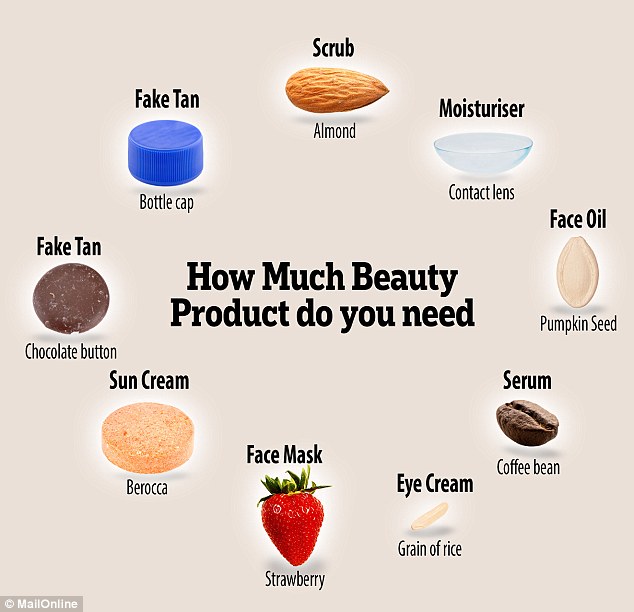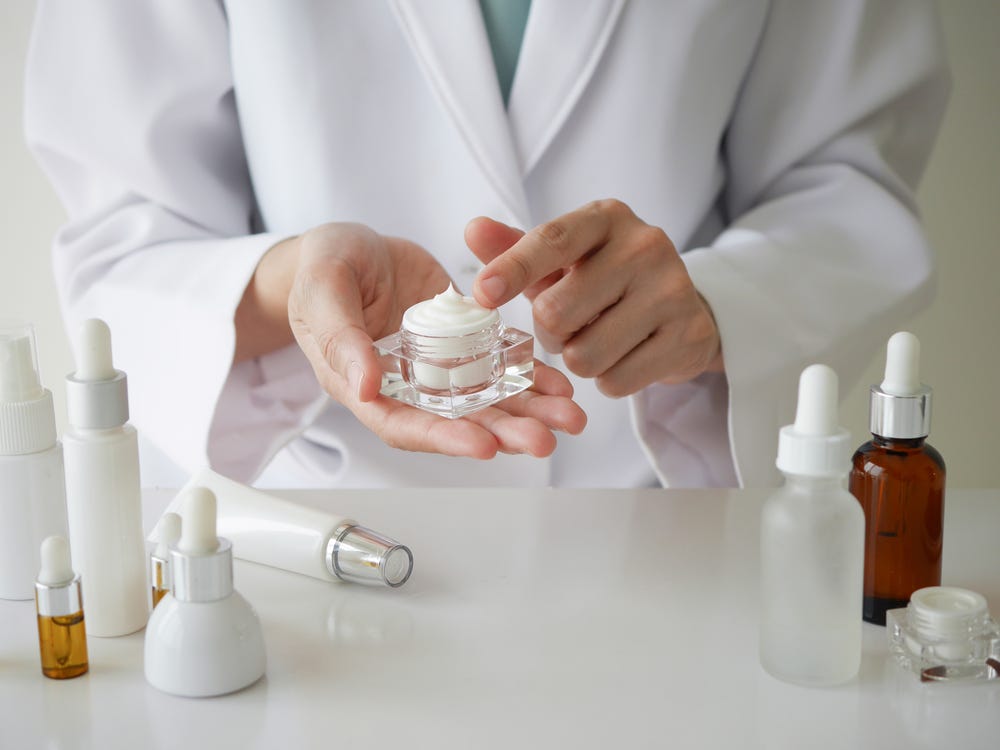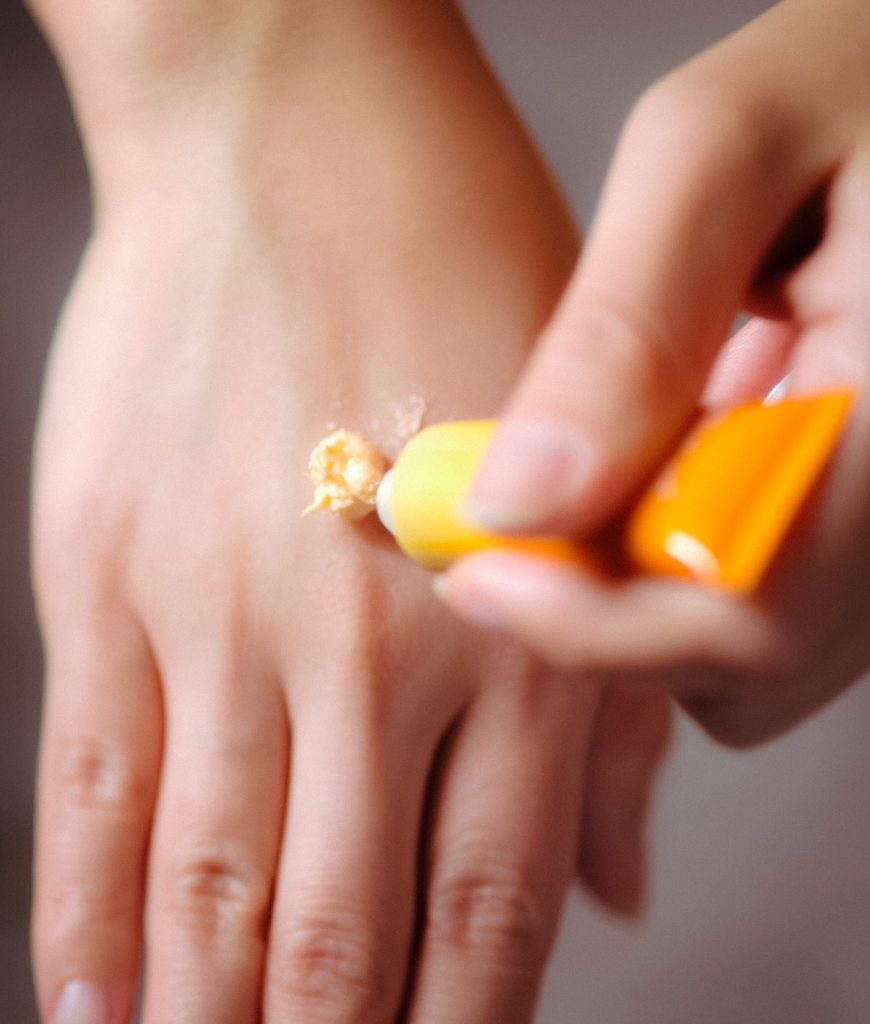When it comes to skin care, we seem to talk endlessly about the type of products and number of steps in our routines, but never about how much of them we should actually be using. Directives usually advise us to “slather on” moisturizer, “dab” eye cream, and “coat our faces in a thin layer” of serum but, really, what the heck does any of that even mean? What I want to know is the right amount of every skincare product to use, right now thank you very much.
At this point, most people have a general sense of which skincare products should be in their daily regimen. Along with cleansers, toners, moisturizers, and sunscreen, many people also incorporate serums, eye creams, facial oils, and masks.
But the real question is: Are you sure you’re applying the right amount of skincare? To ensure that you are, we chatted with board-certified dermatologists Corey L. Hartman, MD, Michele Green, MD, and Hadley King, MD, who offered their top tips on how much product you should be using for each skincare category, and how to best apply it. Keep reading to find out what they had to say.
Considering my holy grail serum retails at $125 a pop (I combine it with drugstore products to balance things out in my bank account, I swear), the thought of overusing it on a daily basis and—gasp—running out of it before absolutely necessary makes my heart hurt. With that in mind, I tend to eke out the ittiest, bittiest drops to ensure it lasts as long as possible. But apparently, there are pitfalls in using both too much and too little of your favorite products. “Underusing products will give you a less than ideal result in terms of desired effect,” says Connecticut-based dermatologist Mona Gohara, MD. “Overusing can create irritation and redness, and it in some cases can cause a filmy or oily residue on your face.”
As a general rule, though, the type of product you’re using matters far more than how much of it you’re applying. “Quality over quantity is the way everyone should address their skin-care regimen,” says Lauren Abramowitz, board certified, PA-C founder of the Park Avenue Skin Solutions. “A pea size amount of any type of skin is usually the gold standard for a retinol or an eye serum, whereas if you’re using a cream for the face and neck you would more than likely use a quarter size.”
While there’s technically no exact science behind how much of your skincare products you should be using (because we all have different skin types, face sizes, and a whole lot of other factors), Abramowitz recommends the below as a barometer.

Cleanser
The face, in comparison to the body, is a much smaller area of skin. As such, there’s no point in over-saturating it with product—doing so is wasteful and doesn’t add to the efficacy of the product’s cleaning ability. With that in mind, Hartman says that one pump (if using a pump cleanser product) or about the size of a dime (for all other cleansers) should be more than enough to fully cleanse the face. That’s because when mixed with water, cleansers typically lather, which creates more substance that you can work from forehead to chin, as well as down onto the neck and chest.
Hartman says that the best way to use a cleanser is to start with a damp face, or to “rub lukewarm water into your hands with the cleanser to generate a lather.” After application, “rub in upward motions on the face, carefully avoiding the eye area (unless the cleanser is suitable for the eyes).” Then, to rinse, he says to use clean, cool water on the face, again moving in upward motions. Doing so will help tighten pores and boost blood flow to the face. When it’s time to dry, don’t rub your face—Hartman says to pat it dry to avoid any unnecessary tugging which can lead to premature signs of aging like fine lines and wrinkles.
Whether you choose a gel or a cream cleanser, a dime-sized amount is all you need. For foaming cleanser, one pump should get the job done. Miami dermatologist Alicia Barba, MD, suggests washing once in the morning and twice in the evening if you wear makeup, or only once at night if you don’t wear makeup.
If you use too much: Overusing anti-acne cleansers can leave your skin dry and irritated. “Using more than a dime-sized amount of any cleanser will cause you to go through product a lot faster, with no extra benefits,” says, Chicago-area dermatologist Amy Forman Taub, MD.
If you use too little: “Not using enough cleanser leaves dirt, debris, and makeup on the skin, which can cause clogged pores and lead to breakouts,” says New York City dermatologist Eric Schweiger, MD.
Toners, Essences, and Other Liquids
When it comes to toner—and micellar water and essences, for that matter—many people rely on cotton rounds or reusable cloths to apply, “but you lose a lot of product in the applicator,” Hartman warns. As such, he recommends squeezing toners and essences directly into the palm of your hand.
“You only need about a quarter’s worth,” he says. “Then use your other hand to gently pat the product all around the face.” When doing so, he says to avoid the eyes—and when using toner, specifically, to steer clear of the nostrils and directly around the mouth to avoid irritation.
If you feel like a quarter-sized amount is overkill, Green says that “the right amount of toner should effectively be used for ‘problem areas’ such as the T-Zone.” If you have dry or combination skin, however, she says that you may not need to use as much toner, as it could further dry out your skin.
As for micellar water—which is designed to remove dirt and debris from the skin—the best method is, in fact, a soaked round. If micellar water is a staple in your routine, though, it’s worthwhile to upgrade to reusable rounds (like Last Object’s Last Round Reusable Cotton Rounds, $14), as using cotton pads multiple times a day can get pretty wasteful.
Serums
A tiny bit of serum goes a long way. As such, King says that no more than a dime-sized dollop is necessary to cover your entire face, neck, and chest (because, yes, you should extend your serum that far).
If you’re not one to squeeze your serum into your hand before applying it, though, Green says that a few drops dispersed across the face will do the trick.
For the best (and most even) serum application, though, Hartman specifically says to dot the serum across the areas you want to apply it. “Dot a few times across the forehead, once on the nose and chin, and a few times on each cheek,” he instructs. “Then gently rub the serum into the skin until it is fully absorbed.”
If you use too much: Using too much of any product leaves active ingredients sitting on your skin. Some, such as exfoliating serum, can lead to stinging or peeling.
If you use too little: “If you use too little serum, you will not get the maximal effect,” Barba says.

Eye Cream
The eye area is small, but properly applying eye cream to it can lead to mighty anti-aging results. According to Hartman, a pea-sized amount of cream is plenty to go around both eyes. Notice how we said around? That’s because contrary to popular belief, eye cream isn’t solely meant for under the eyes but above and around them, too.
Amount aside, Hartman reminds us of the importance of pressure (or, rather, lack thereof) when applying eye cream. “Use your ring finger,” he says. “Your ring finger will apply less pressure to the delicate eye area than your pointer finger would. [This] can help reduce pulling or tugging at the skin, which can lead to fine lines and wrinkles.”
If you use too much: Using too much eye cream can leave your skin sensitive, clog your pores, and irritate your eyes. Putting too much on your skin can also make it challenging to apply your makeup.
If you use too little: Skimping on eye cream can leave that delicate skin dehydrated and keep makeup from lying on the skin properly, Taub says.
Moisturizer
Generally speaking, King says that one to two milligrams of moisturizer per square centimeter of skin (or a dime- to nickel-sized dollop) should be enough to adequately hydrate your whole face. That said, your skin type plays a role—and can up the amount.
“For balanced to combination skin, a nickel-sized amount of moisturizer works well,” Hartman says. “If you have overly dry skin, you may benefit from using slightly more than a nickel size to ensure you have enough.”
No matter how much moisturizer you apply, the important thing is how you apply it. “Wait to apply moisturizer until your skin feels completely dry after applying serum,” Hartman says, noting that doing so will help allow your serum (and its targeted benefits) to fully sink in, rather than get diluted by moisturizer before having the chance to do so. Once it’s time to apply your moisturizer, Hartman says to rub it in in gentle upward circles across the whole face—again, doing so will help boost circulation and create a more lifted appearance.
If you use too much: Overdoing moisturizer can make your skin shiny and lead to breakouts. It can also feel heavy on your skin and make it harder to put on your makeup.
If you use too little: Your skin may feel tight, flake, and look dull because it’s not as hydrated as it could be.
Sunscreen

You know the drill: No matter the time of year, the temperature, or how often you plan on going outside, wearing sunscreen is important, as it can help protect against stray UV rays which can gleam through windows and even the cloudiest skies.
You can’t just rely on your SPF-infused moisturizer though. “Most people only apply 25-50 percent of the recommended amount of sunscreen,” King says. “The guidelines are to apply approximately two milligrams of product per square centimeter of skin. This means one ounce—that’s enough to fill a shot glass—to the exposed areas of the face and body; a nickel-sized dollop to the face alone.”
If you use too much: “Most people don’t use enough sunscreen,” Schweiger says. “In this case, there is no such thing as using too much.”
If you use too little: You could get sunburn. Over time, you might also get sun-damaged skin that looks old before its time. You could also get skin cancer.
Facial Scrub
A dab is enough to exfoliate. Taub recommends using a scrub with round beads, not jagged edges that could make small tears in your skin.
If you use too much: Your skin may become dry, irritated, red, and sore. Other products will sting when you put them on your face.
If you use too little: There’s no downside.” Scrubs are not mandatory, and they do not make or break a skin care routine,” Barba says.
Retinoid
Start with a dab of retinoid product for your entire face. Gradually work your way up to a nickel-sized amount if your skin can tolerate it, Schweiger says.
If your skin has trouble adjusting to a retinoid, ease up. Mix it with your moisturizer before applying, and use it only three times a week instead of five.
If you use too much: Using more than the recommended amount can lead to dryness, redness, and peeling.
If you use too little: Even just a little bit of retinoid will improve your skin, but it will take longer to see results.
Face Oils
As with serums, a little bit of face oil goes a long way. And most of the time, Hartman says, two to three drops is plenty enough to cover your entire face.
“I recommend you only apply face oils at night, to ensure they don’t interfere with your daytime sunscreen,” Hartman says, noting that they should be patted on after you apply moisturizer. By putting them on after (as opposed to before) moisturizer, face oils can help lock in all the hydrating benefits of the cream or gel cream you use.
Masks
Masks require a bit more product to get the job done. Unlike most other skincare products, though, there’s no one set amount for masks, as they typically vary based on the specific product. That’s why Green recommends applying them as directed—both in terms of amount and frequency.
As a general rule of thumb, Hartman says that “the amount of product you use for a mask should be enough for a thin layer on the face.”
How much product should I use on my skin?
If you're using a moisturizer that suits your skin type, a nickel-sized amount should be enough for your whole face. If you use too much: Overdoing moisturizer can make your skin shiny and lead to breakouts.
How many products should I use on my face?
Experts agree that the skin only needs three to four products—and sometimes zero skincare products—to thrive.